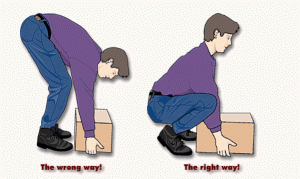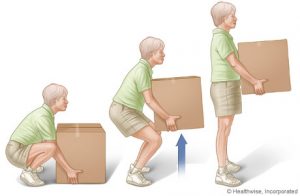How is your lifting technique? It’s probably not something you think about unless you happen to work in a job where physical labor is an important element. It might seem trivial, but this is a big problem! In actual fact, most of us are doing some kind of heavy or repetitive lifting through the day.
Researchers who study occupational injury point to awkward lifting posture, heavy lifting and repetitive lifting as common triggers of lower-back pain. Today, lets look at how you can prevent these injuries taking place in the first instance!
Is lifting technique important to me?
It’s a common misconception that concerns around lifting technique are limited to those working in manual jobs, perhaps in the construction industry, in the warehouse or perhaps something more unusual, like baggage handling at the airport. There’s no doubt that proper lifting technique is vital in these professions, but these basic principles are relevant to almost everyone! The key thing to ember is that it isn’t just heavy, but also repetitive lifting that can be a problem.
Are you a mum? – perhaps your child doesn’t weigh that much (or perhaps they do!!) but you’re picking them up often, and frequently in a poor position.
Do you commute on public transport? – Your bag or rucksack probably weighs more than you think, and you might be holding on to it for a long time!
Work in an office? – Perhaps you lift infrequently, but those occasional items you do lift might actually be very heavy, boxes of printer paper, water cooler bottles and even stacks of folders, if lifted poorly can and do cause injury!
Practice your technique 
Particularly in workplaces that demand a lot of lifting training in correct lifting is critical. A study comparing novice and expert materials handlers revealed that the less experienced workers bent their lower back an average of 12 degrees more and their knees an average of 19 degrees less compared more experienced workers – the difference isn’t a small one.[1]
Well give some tips in a moment, but if you do happen to work in an occupation which demands this kind of heavy work, and you haven’t received proper training, make an appointment today and we can work with you to evaluate and improve your lifting technique. This is especially relevant for independent or self-employed contractors. Why get some tailored advice before you need injury rehab!
Get your posture right
Like most things spine related, when it comes to safe lifting, the importance of correct posture cannot be overstated. You have probably heard the common advice to “lift with your knees, not with your back” – often the common advice isn’t totally accurate, but on this occasion it is!
A recent study which measured a group of healthy men lifting a 10 kg weight confirmed the load that not bending your knees can impose on the spine. In the study, scientists measured electrical activity in the men’s trunk muscles and the pressure between vertebrae of their spines. Both the load on their spines and activity in their muscles were significantly higher when the men bent their backs, rather than their knees while lifting[2].
Therefore, bend your knees, not your back!
Practice good lifting habits
Having the right posture and lifting from the knees is the best single take away from this blog – just doing this will help to drastically reduce your chance of causing or aggravating an injury. However, there’s lots more you can do!
- Start with your body as close to the load as possible, avoiding reaching out to grasp it. This keeps your centre of gravity where it should be.
- Avoid reaching over your head – use a ladder instead.
- Focus on your legs when lifting – shifting your mental focus has been shown to activate muscle groups more effectively.
- Don ‘t arch or twist your back – keep it straight.
- Hold the load close to your torso between your shoulders and waist for minimal back strain.
Know Your Load
Numerous trials reveal that not knowing roughly how heavy a load is before lifting subconsciously influences posture, balance and spinal load. Lifting an object that is heavier than anticipated can throw your body off balance, especially if you are already in a less-than optimal lifting posture and strain the lumbar region[3].
It may seem that this would only be a problem when the load is heavier than expected, but researchers have also identified potential hazards when the weight is less than you thought. Anticipating and preparing the body for a heavier load alters the impact of the load on the spine and throws the body off balance, risking injury[4].
Another possible hazard comes from lifting a load that is asymmetric – that is to say that it’s heavier on one side than the other. Researchers have found that people lifting such loads have to quickly shift their trunks to com pen sate for the unexpected irregularity. This decreases stability of the spine, putting these individuals at risk for hurting their lower backs[5].
Don’t rush.
Evidence suggests that trying to lift items quickly also increases the risk of injury. For instance, research shows that not taking time to lift carefully is a common factor in back injury for nursing assistants working in residential care facilities. Those who reported having adequate time to complete their assigned tasks were 35 percent less likely to be injured on the job, compared with nursing assistants who feel they don’t have enough time – that’s another significant difference[6].
When allowing time to lift carefully, also give yourself time to rest as needed – this one is especially important for those manual handling workers. Fatigued muscles significantly boost the risk of injury. In one investigation, a group of men raised and lowered a 13 kilogram box 50 times consecutively . Researchers observed that the positions of the men ‘s knees, hips, elbows and trunks changed as they became more tired. These changes result in greater strain on the already tired muscles of the back[7].
Exercise helps
Notwithstanding the point just made about proper rest, an exercise regimen targeting strength as well as balance and coordination can help to reduce injury risk. Resistance training and weight training will build muscle strength , while some sports like rock-climbing (or yoga, if you prefer something less extreme) are great for improving balance.
Healthy spine = safe lift.
Regular chiropractic care helps to keep your spine healthy, supple and in correct alignment. In this sense its vital to avoiding lifting injuries. If you are already struggling with a spinal issue your chances of aggravating your existing problem are very high when undertaking even light lifting.
Chiropractic is therefore a great preventative measure, but if you already have back pain from a lifting injury, another injury, or perhaps an unknown cause, we can help. Chiropractic adjustments correct musculoskeletal damage, decrease pain and help ng you return to your normal daily active ties without the dangerous side effects of painkillers.
[1] Ergonomics 20 I 0;53:1 239-53
[2] Spine 2006; 31 :18-23
[3] Arch Phys Med Rehabil/ 2002;83 :48-59
[4] Ergonomics I 997;40:559-75
[5] Spine 2003; 28:764-70
[6] J Adv Nursing 201 1; Epub
[7] Spine 2003; 28: 1810-20


